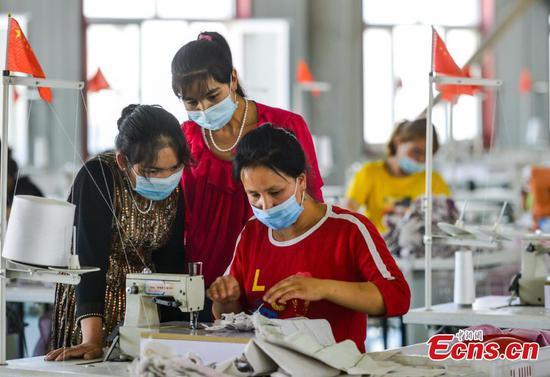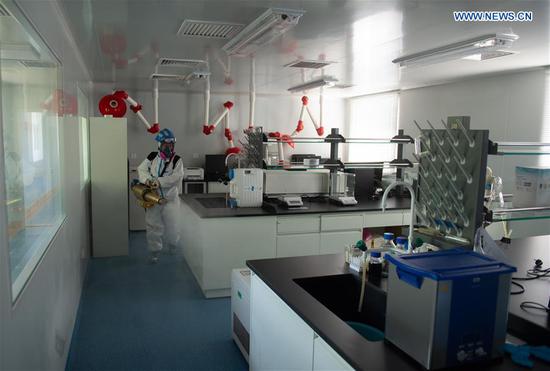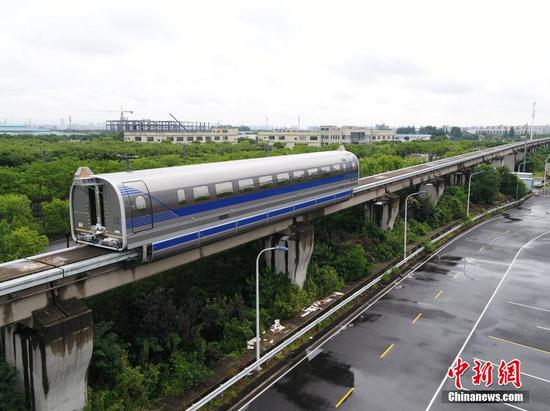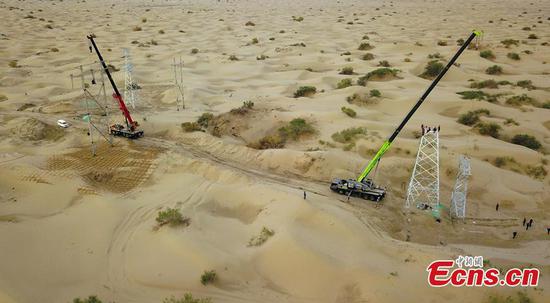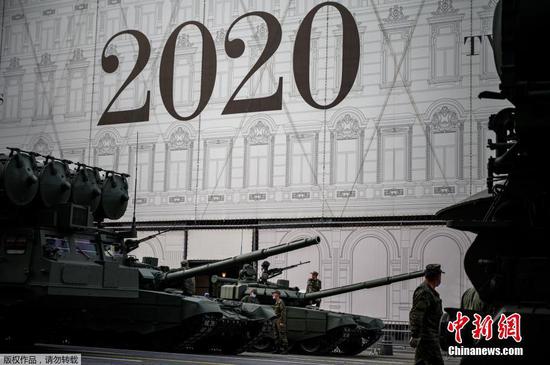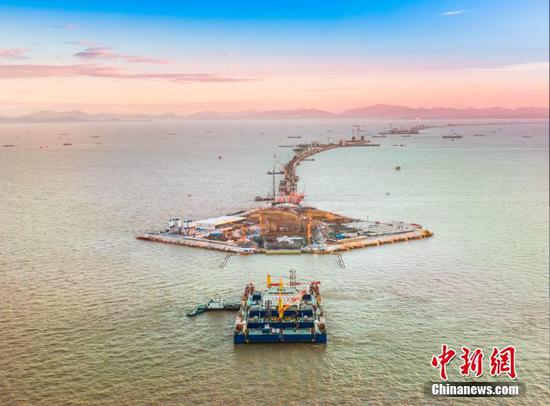The global industrial chain is facing huge uncertainties amid Sino-US trade frictions and the unexpected epidemic. In this context, the global industrial chain layout will give more consideration to the balance between safety and efficiency, and will present new features of diversification and block.
Meanwhile, the digital development of the global industrial chain is particularly worthy of attention. In this regard, China can leverage its advantages to seize such historic opportunities. There will be challenges from some attempts to cut dependence on China's supply chain.
The United States continues to tighten restrictions on China in the high-end technology sector. As of May, more than 300 companies and institutions in China had been included in the so-called entity list. At the same time, Chinese companies that want to invest in the US are subject to stringent and harsh scrutiny by the Committee on Foreign Investment in the United States.
The US is also exerting pressure on other countries through international networks and tightening its technical restrictions on China. Science and technology cooperation and personnel exchanges between China and the US have also been affected.
On the other hand, the country's industrial chain is facing mounting external competition. Owing to the rapid rise of domestic labor costs, the labor-intensive industries represented by the textile and apparel industry continue to move outward. From 2007 to 2018, the clothing exports of Southeast Asian and South Asian countries rose from 2.9 percent to 18.5 percent in the global market share.
At the same time, regional trade agreements and bilateral trade agreements increased. Southeast Asian countries are at the intersection of important regional free trade zone agreements such as the CPTPP and the RCEP. In particular, Vietnam reached the EU-Vietnam Free Trade Agreement; thereby, its competitive advantage has increased significantly.
The above two aspects, coupled with the impact of uncertainties including the epidemic, have caused more and more concerns that the long-term diversified development trend of the global industrial chain will weaken China's position in the global industrial chain.
However, under the diversified development trend, China itself is also one of the options for the diversified layout of the global industrial chain. At the same time, China is also one of the world's largest consumer markets. Therefore, China will undoubtedly still occupy a very important role in the global industrial chain. Diversification may have a certain impact on China's industrial migration, but it is not equivalent to cutting dependence on China's supply chain.
It should also be noted that the transformation from "globalization with a single efficiency orientation" to "globalization with a balance between efficiency and risk" means that we have to withstand a higher cost of globalization and will lead to a slump in global economic growth. A lower global economic growth rate, in turn, will slow down the process of globalization.
It's safe to say that the industrial chain will become more digital and capitalized in the medium and long term, and will have an impact on the existing advantage pattern due to the following three reasons:
First, the epidemic will have an impact on production methods in the medium term and increase labor costs. The spread and duration of the epidemic have greatly exceeded previous common expectations, and there are concerns of a possible recurrence.
It means that the epidemic will continue to have an impact on existing production methods until a vaccine is successfully developed and popularized. In the manufacturing industry, the cost of daily epidemic prevention for workers will rise significantly. Even if their wages remain unchanged, the cost of using labor will rise.
Second, another consequence of the impact of the epidemic is that the capital cost will continue to remain in a low interest rate and stay there over the long term. In order to deal with the epidemic, major developed economies such as Europe, the US and Japan have generally implemented unconventional fiscal policies and cooperated with an unlimited amount of loose monetary policies.
As the industrial chain will move toward a balance between efficiency and risk, the potential growth rate of the global economy will also tend to slow down. Against this background, it is difficult for global fiscal situations to have obvious signs of improvement.
Third, rising labor costs (unlike rising wages) and capital costs will maintain a low interest rate environment. These two conditions will stimulate digital technology to develop at a faster rate.
The epidemic has changed the business model and directly promoted the development of the online economy and digital economy from the demand side. At the same time, the epidemic will also change the relative prices of labor and capital in the medium and long term, and have a profound impact on the global supply chain from the supply side.
From a technical perspective, most of the emerging technologies such as artificial intelligence and 3D-printing are skill-based, and it appears low-and medium-skilled labor force may find their current jobs at risk. Together with the marginal changes in the relative prices of labor and capital elements, the proportion of labor input in manufacturing production will decline, while the proportion of capital will increase accordingly.
Combining the three factors, the global industrial chain will show a more obvious trend of digitalization and capitalization. The application of emerging technologies will trigger more substitution of capital for labor, thereby changing the existing international comparative advantage pattern. In this process, countries that are catching up with the process will face higher thresholds.
Amid all this tumult, China faces opportunities in the digitalization of industrial chain. The digitalization and capitalization of the industrial chain is a medium-to long-term trend in the future. During this process, the comparative advantage pattern of global labor division will be redefined.
Although some countries have comparative advantages in labor costs, the development of the digital economy lags behind, or the construction of infrastructure required for the development of the digital economy faces bottlenecks. The comparative advantages of these countries need to be reassessed. For developed countries, the biggest obstacles to the development and realization of the digital economy are as follows:
First, their related public infrastructure construction is facing difficulties.
Second, the balance between personal privacy protection and business efficiency is facing more difficulties.
Third, most developed economies are already facing a certain industry hollowing, which means that they will also face higher costs to realize digital integration on the physical industry chain.
In comparison, China has obvious advantages.
First, China's digital economy has already achieved a very good foundation. The infrastructure is relatively complete, business innovation is at the forefront globally, and it has certain competitive advantages in emerging technologies. The number of unicorn companies is just behind the US and far ahead of many other countries.
Second, China has a complete industrial chain and a suitable production supporting network, which provides a good integrative foundation for the digitalization of the industrial chain.
It is undeniable that China's manufacturing sector still has a gap with developed countries, and it still has certain vulnerabilities in certain areas. However, China's current production capacity, transportation and logistics level, production supporting network and many factors all provide a solid foundation for the digitalization and capitalization of the industrial chain.
The digitalization of the industrial chain may change or even subvert China's labor cost disadvantage compared with other developing countries. Though China's capital cost is still higher than that in other major developed economies, Chinese companies can enhance their international competitiveness through overseas financing and the use of low-cost funds from overseas capital markets.
At the same time, the nation is also actively exploring ways to open up monetary policy transmission mechanisms to reduce corporate financing costs. Overall, the trend of digitalization and capitalization of the industrial chain is a historic opportunity that China can and must seize.
Another problem seemed remote but has to be considered in an early phase. If the digitalization and capitalization of the global industrial chain become a development trend, then the distribution of national income will also be more inclined to capital than laborers.
In this context, the income gap and even unemployment will become serious global challenges. China is expected to be at the forefront of the world during this process but will also face such a test first.
How to make the digitalization and capitalization of the industrial chain more inclusive? How can the government play a better balancing role in the redistribution process? These issues are worth thinking about.
The writer is a research fellow at the Institute of World Economics and Politics, part of the Chinese Academy of Social Sciences.











